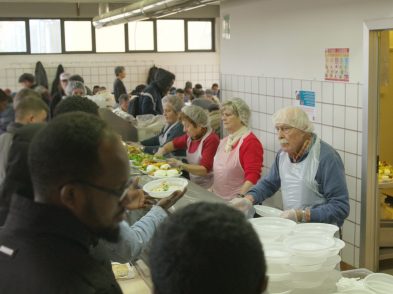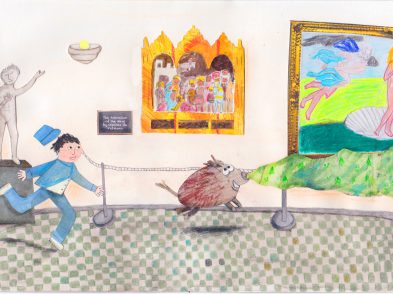The seismic risk of a city is based on a combination of three factors: level of danger (frequency and intensity of seismic activity in the region), vulnerability (fragility of buildings, infrastructure and amenities) and exposure (population density and historical, artistic and monumental heritage). But what’s the situation in Florence? Is the city at real seismic risk? The Florentine interviewed experts in the field.

To find out about the level of danger we spoke with Professor Maurizio Ripepe, lecturer in geophysics and head of the geophysics group of the Department of Earth Sciences at the University of Florence. “Florence is unlikely to be the epicentre of major earthquakes. The main risk to the city comes from earthquakes that could occur in the Mugello or in Garfagnana. The maximum expected magnitude in those Apennine areas is 6–6.5. The earthquake that struck Amatrice and the other villages had a magnitude of 6.2.”
“Therefore, in Florence we must assess how the energy of quakes, even distant ones, affects our buildings. Seismic intensity depends on the type of terrain. Regrettably, Florence consists of terrain that fosters and, at certain points, amplifies the intensity of the tremors. This depends on the Arno River, which, before it became regimented, flooded on a regular basis, giving rise to swamps and wetlands, with sands, as well as muddy and clay-rich terrain.”
In actual fact, Florence has been the epicentre of earthquakes. From the 14th century to the present day, eight quakes have hit the Tuscan capital, with magnitudes varying between 4.0 and 5.2. The most recent—on May 18, 1895—weighed in at 5.2 on the Richter scale. Damage to the city was limited: statues, majolicas, decorations, stuccowork and ancient objects of priceless value were the worst affected, as they fell and shattered in an instant.
Florence today is a metropolitan city and, to a certain extent, more vulnerable than in the late nineteenth century. The area struck by that bygone earthquake is more built up and populated now compared to the past. If a similar tremor were to occur today, its effects would be worse than those at the time of the last major Florentine earthquake.
“Our Department, in collaboration with the Department of Architecture (DiDA) led by Professor Mario De Stefano, is conducting research to determine the vulnerability of the entire city,” continued Professor Ripepe. “It’s a project financed by the City of Florence and the Ente Cassa di Risparmio di Firenze bank. The aim is to create a map that indicates the varying levels of vulnerability throughout the city.”
But how vulnerable are Florence’s monuments and works of art? Studies have been carried out by the Uffizi, the Accademia and the Opera di Santa Maria del Fiore regarding the Baptistery and Giotto’s Bell Tower. The outcomes will be published shortly in a report by the Italian Ministry of Cultural Heritage, headed up by Giuseppe Giorgianni. And while Florence’s historic buildings are not particularly vulnerable, what is critical, however, is the positioning and securing of the works housed inside them—a matter that warrants timely verification.
Marco Tanganelli and Stefania Viti, researchers in construction techniques at the Department of Architecture (DiDA) of the University of Florence, describe the difficulties involved in conducting surveys in places like the Accademia and the Uffizi.
“It’s really difficult to work in museums because the needs of visitors must be met and attention must be paid to the art. Moreover, these historic buildings have changed and grown over the centuries, layering changes and uses, often with the addition of different materials. From a technical and scientific perspective it’s professionally rewarding as it enables us to apply a range of techniques, methodologies and tools.”
While plenty of building monitoring has been (and continues to be) carried out, a field that requires development is the works of art within these historic “containers”. The DiDA has presented a pilot project (awaiting approval) to the Bargello in order to assess the museum’s resilience, that is, to measure the risk level in case of seismic activity and to pinpoint the main critical areas for the works, mostly sculptures, housed in the museum.
To understand the level of exposure, we spoke with Carlo Francini, manager of the UNESCO Office of the Municipality of Florence since 2005 and site manager of the UNESCO World Heritage site “The Historic Centre of Florence”.
“In terms of research, analysis and monitoring we’re at an excellent level… Where we need to work harder is on the application of techniques and tools to secure our artistic heritage. What must be cultivated is a ‘habit of security’, which must be put into effect though a checklist of things to do.”
The UNESCO office in Florence regularly draws up a “Management Plan of the Historic Centre of Florence”, which contains analysis, data, projects and initiatives to safeguard, protect and promote all of the city’s heritage.
“The city has become increasingly aware about security and risk management in terms of safeguarding heritage. We mustn’t forget that, in addition to seismic risk, Florence is also subject to the risk of flooding. But there’s another aspect that’s even more critical to our city, and it’s not a risk but a tangible danger for the here and now: hyper-tourism.”
But that’s another story.








